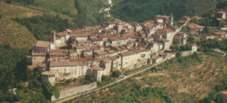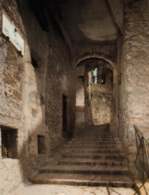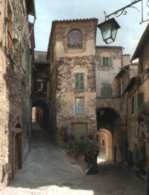STRONCONE

Some historical information on Stroncone (TR)
Placed on a wonderful olives-hill (450 mt a.s.l.) Stroncone is a typical medieval town. It was founded in the 10th century, during the so-called “fortifications' period” (the place was first mentioned in the “Chronicon Farfensis” by Gregorio da Catino in 1012) and it still preserves its charming features: narrow and meandering little roads, beautiful stone-doorways and the old well just inside the city walls. Behind these walls, after closing the city-gates, the inhabitants of Stroncone were forced to stay shut in the town to defend their autonomy and especially their Guelph choice; the neighbouring town of Narni was its strongest enemy to such a pass, that the Pope Innocenzo III in 1209 was compelled to lay the city under an interdict and in 1215 he ordered the people of Narni to rebuild everything they destroyed inside that town and in the whole land around it. Different donations to the Monks of Farfa got Stroncone to be ruled by the Abbey for a certain period, after which it was mentioned in 1192 in the book “Liber Censuum” by Cencio Camerario (the Treasurer of the Papal Court) as a tributary to the Roman Church for the annual Census for “100 soldi”. Since that day Stroncone remained loyal to the Church and this choice was well testified by adding a white cross and keys (symbol of the Pope's authority) on a red field to its original coat of arms, displaying a castle on a blue field. In 1404 its inhabitants chased Andrea Tomacelli out of the town: taking sides with Ladislao, the king of Naples, he settled down in Stroncone and on the occasion of the passage of the Pope, Pio II (December, 14th 1462) he bound up his coat of arms with a fesse (in a form of laurel - and oak -bows) on which there was the inscription “Stronconium Liberum Romano Tantum Pontifici Subiectum Cui Servire Libertas”. In 1527 Stroncone was besieged by the troops marching towards Rome, and it could avoid the destruction and the pillage only thanks to the help of Terni, whose inhabitants paid 2340 scudi. In 1799 it held out against the French army for seven days, but on the eighth day the troops entered the town (after an agreement with the besieged people) and finally they sacked it. In 1860 Stroncone became a free town of the Kingdom of Italy; in 1947, after twenty years of annexation to the city of Terni, it conquered its
authority.

Pictures
click on the picture to enlarge it




